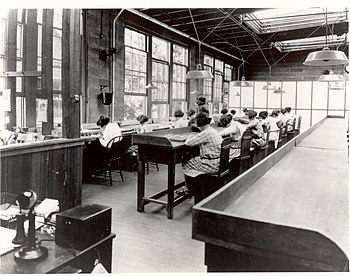 I just finished reading The Poisoner's Handbook: Murder and the Birth of Forensic Medicine in Jazz Age New York. Similar to Sam Kean's book about the periodic table (The Disappearing Spoon), this book focuses on stories about some rather dangerous and fascinating chemistry. Here, author Deborah Blum culls stories from the Prohibition Era in New York City. Before that time, New York City's police department was poorly run. Then in 1918, Charles Norris was appointed as chief medical examiner (M.E.); Norris was the first M.E. who actually had suitable credentials for the position. Once in the department, Norris brought toxicologist Frank Gettler on board. Together, they helped to establish the role of forensic medicine in the investigation of crimes. Both Gettler and Norris worked countless hours in the laboratory to establish tests for the lethal doses of various poisons; they also investigated some of the more notorious crimes of the Prohibition Era.
I just finished reading The Poisoner's Handbook: Murder and the Birth of Forensic Medicine in Jazz Age New York. Similar to Sam Kean's book about the periodic table (The Disappearing Spoon), this book focuses on stories about some rather dangerous and fascinating chemistry. Here, author Deborah Blum culls stories from the Prohibition Era in New York City. Before that time, New York City's police department was poorly run. Then in 1918, Charles Norris was appointed as chief medical examiner (M.E.); Norris was the first M.E. who actually had suitable credentials for the position. Once in the department, Norris brought toxicologist Frank Gettler on board. Together, they helped to establish the role of forensic medicine in the investigation of crimes. Both Gettler and Norris worked countless hours in the laboratory to establish tests for the lethal doses of various poisons; they also investigated some of the more notorious crimes of the Prohibition Era. Each chapter is focused on a different poison (e.g., radium, methyl alcohol). Blum chooses stories that are all linked to Gettler and Norris and the development of forensic medicine. A few of the chapters focus on what are likely seen as standard poisons, cyanide and arsenic. These poisons were readily available at pharmacies and hardware stores; thus, murders by these methods were almost commonplace. The work of Norris and Gettler established tests to help police convict poisoners who decided to use rat poison to get rid of an irksome husband or mother-in-law.
Of course, because the book focuses on the Prohibition Era, many stories described the effects of methyl alcohol and ethyl alcohol. When alcohol was outlawed in the US, the government decreed that industrial alcohol should increase the percentage of methyl alcohol. This was intended to decrease the chance that the alcohol would be imbibed. Instead, there was a sharp increase in the number of alcohol-related fatalities; these were mostly poor folks who couldn't afford safer alcohol. Blum discusses the chemists who were involved in bootlegging during this time period, which gave me an excellent idea for a new show: Breaking Bad meets Boardwalk Empire. Imagine the mild-mannered chemists like Walter White who found themselves in league with the unscrupulous bootleggers like Nucky Thompson!
 |
| from Wikipedia |
Despite the amount of press that the case of the Radium Girls received, products containing radium were still on the market. It wasn't until the death of millionaire Eben Byers in 1931 that the safety of these products was called into question. On the advice of a physician, Byers was regularly drinking a product called "Radithor" for the treatment of an arm pain. The state of Byers' body was similar to those of the Radium Girls. Shortly after Norris and Gettler released the results of their autopsy, the government issued a warning regarding the safety of drugs like Radithor. In 1932, the products were officially banned by the government.
In the final analysis, The Poisoner's Handbook was interesting and included lots of off-beat stories from a strange time. However, its focus is more on history and forensics than chemistry. Thus, I slightly preferred The Disappearing Spoon.
